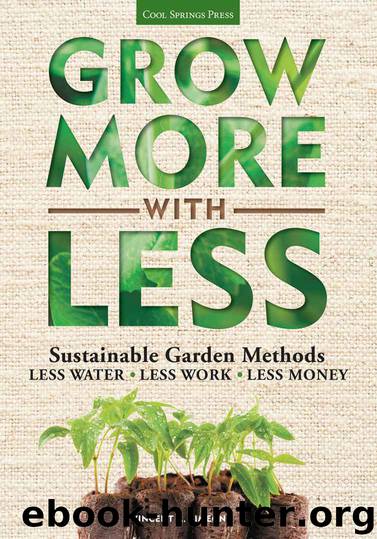Grow More With Less: Sustainable Garden Methods: Less Water * Less Work * Less Money by Simeone Vincent A

Author:Simeone, Vincent A. [Simeone, Vincent A.]
Language: eng
Format: epub
Publisher: Cool Springs Press
Published: 2013-12-15T00:00:00+00:00
“Integrated pest management allows gardeners the opportunity to incorporate a variety of pest control methods to keep harmful pests at bay.”
MANAGING INVASIVE SPECIES
Within the realm of insects and plants, there are good guys and bad guys and in nature, there is a delicate balance between invasive exotics and native species. In the garden setting, with a constant influx of new and exciting plant species and varieties being introduced, keeping this balance is even more difficult. Invasive insects and plants have become a serious issue worldwide, and the environmental and economic impacts are significant. For example, according to the U.S. Forest Service, the Asian longhorn beetle (ALB) and the emerald ash borer, both exotic, wood-boring insects, cause an estimated $1.7 billion in local government expenditures annually and approximately $830 million in lost residential property values every year. Norway maple (Acer platanoides) is an exotic shade tree from Europe that is on the invasive species list in several states. It is a very fast-growing, weak-wooded tree that produces heavy shade and propagates readily by seed. In spring you will observe a carpet of tiny green seedlings germinating on the surface of the soil. Because of this invasive characteristic, Norway maples are able to crowd out native species, such as sugar maple (Acer saccharum). Since many animals rely on the sugar maple as a food source and it is also a very important species to the maple syrup industry, it is easy to understand why the Norway maple presents a problem both to native and cultivated landscapes.
Monitoring is a key element of any successful IPM program. Regularly inspecting the landscape is critical because it will help identify potential problems before they become an issue. A gardener must know what is going on in his or her own backyard in order to properly manage it. The occurrence of pests on landscape plants varies from year to year and in different locations within the garden. But at the same time, patterns or cycles may form allowing you to be better prepared the next time a similar issue arises. In addition, monitoring allows gardeners to anticipate proper timing of control methods. In the past, conventional pest management programs incorporated cover sprays—regular use of pesticides to control pests, whether there was a pest present at the time or not. These cover sprays were aimed at protecting plants without truly knowing if there was a problem or what the consequences would be for beneficial wildlife. Pest levels were generally unknown, and often more harm than good was done. This ultimately resulted in overuse or waste of pesticides and reduction in beneficial insect populations, which typically help keep pest populations in check. Cover sprays and lack of knowledge about what is going on in your garden are counterproductive to both sustainability and IPM.
Download
This site does not store any files on its server. We only index and link to content provided by other sites. Please contact the content providers to delete copyright contents if any and email us, we'll remove relevant links or contents immediately.
Periodization Training for Sports by Tudor Bompa(8170)
The Body: A Guide for Occupants by Bill Bryson(4974)
The MacArthur Bible Commentary by John MacArthur(4749)
The Sports Rules Book by Human Kinetics(4294)
What It Really Takes to Get Into Ivy League and Other Highly Selective Colleges by Hughes Chuck(3696)
Marijuana Grower's Handbook by Ed Rosenthal(3622)
The Sprouting Book by Ann Wigmore(3543)
The Martian by Andy Weir(3306)
Salt, Fat, Acid, Heat: Mastering the Elements of Good Cooking by Nosrat Samin(3108)
The Bread Bible by Rose Levy Beranbaum(3004)
Harry Potter 4 - Harry Potter and The Goblet of Fire by J.K.Rowling(2990)
Sapiens and Homo Deus by Yuval Noah Harari(2987)
The Marketing Plan Handbook: Develop Big-Picture Marketing Plans for Pennies on the Dollar by Robert W. Bly(2975)
Classic by Mary Berry(2942)
Martha Stewart's Baking Handbook by Martha Stewart(2796)
Screenplay: The Foundations of Screenwriting by Syd Field(2574)
The Plant Paradox by Dr. Steven R. Gundry M.D(2547)
50 Economics Classics by Tom Butler-Bowdon(2523)
The Cambridge Grammar Of The English Language by Rodney Huddleston Geoffrey K. Pullum(2382)
